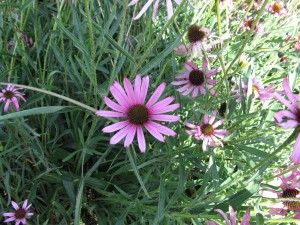Dependable Tennessee coneflowers (Echinacea tennesseensis) bloom almost all summer (USDA hardiness zones 4-8). That’s three months long. Plants are covered with pale pink, flat ray flowers; blooms measure 2 to 3 inch across with greenish-brown centers or cones. It is a great addition to hot dry sites, including shallow rocky soils, conditions that would challenge other coneflower species. Group several together in a perennial border, meadow, or wildflower garden. New compact forms grow well in containers.
This Echinacea species grows 18 to 30 inches tall. It thrives in full sun and in moist, well-drained soils. After the first year, plants tolerate dry soil conditions. Plants tend to be floppy in partial shade and need staking. From mid-June into September TN coneflower blooms non-stop. The petals extend out or up and seem to follow the sun. The pale pink petals do not reflex backwards like popular purple coneflowers (E. purpurea).
TN coneflowers have no serious insect or disease problems. Japanese beetles, powdery mildew and leaf spot are occasional problems. They do not benefit from high soil fertility, which tends to weaken stems. Flowers attract many species of butterflies and birds (particularly finches). Deer generally do not bother coneflowers. Every 4 to 5 years divide clumps when the garden bed becomes overcrowded. Plants usually re-bloom without deadheading; periodic removal of spent flowers does improves overall bed appearance.
Hybrid cultivars:
‘Rocky Top’ is a compact grower with pastel pink on 2 to 3 feet tall and 1 foot wide plants.
Pixie Meadowbrite™ is a dwarf form (18 inches tall and 20 to 24 inches wide) with medium pink flowers.
At one time Tennessee coneflower was listed as endangered; it is easy to find in commerce today.



 Posted in
Posted in 
